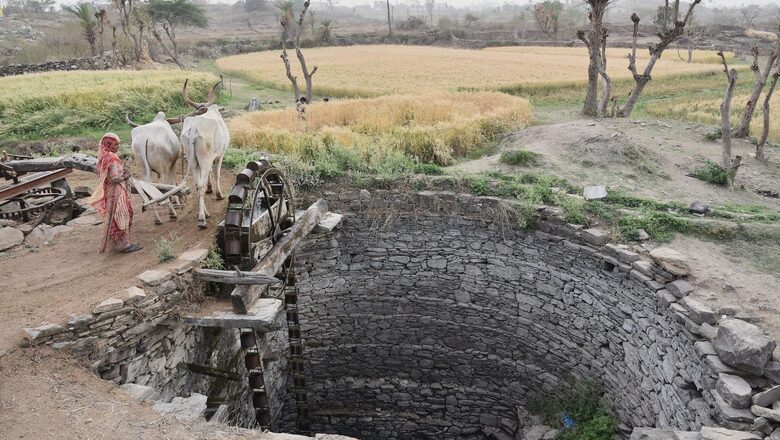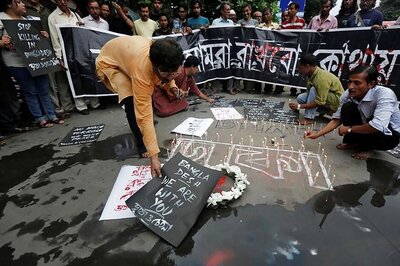
views
The latest water level data collected by Central Ground Water Board (CGWB) through a set of monitoring network during November 2021, when compared with the decadal mean of November 2011 to November 2020, indicated that about 30% of the wells monitored have registered decline in groundwater level.
Since groundwater is used for multiple activities, 90% of it is pumped out for agriculture, leaving only 5% to be used for drinking purposes. The situation worsens with variations in the monsoon rainfall, which is fraught with uncertainty. Despite a normal monsoon over the country as a whole, as many as six subdivisions, including Uttar Pradesh, Bihar, Jharkhand and West Bengal, remain deficient in rains this year, with several districts staring at a drought-like situation. Bihar alone faces a deficit of nearly 32%. This puts additional pressure on the groundwater resources due to high demand of water for the rice-producing states.
Talking about the issue, Vini Mahajan, Secretary, Drinking Water and Sanitation, Ministry of Jal Shakti, says: “Excess withdrawing of water for agricultural purpose can itself become a challenge. Everyone has to get at least about 55 litres of water per capita household which is not humungous, but people have not even got that. So this could become an issue, unless we are able to make sure that agriculture uses its water more wisely through changing in cropping patterns, or better irrigation techniques.”
In order to ensure the stability of the tap connections, the government now requires states to certify that the source is good for round the year water supply because some sources dry up during summer. The certificate must be signed by the revenue department officials and if the source isn’t sustainable, then they need to figure out an alternate source — a nearby dam, storage or river. Recharge of groundwater through rainwater harvesting is also being prioritised.
The situation is critical for states like Punjab (78%) which remain the most affected with 117 out of total 150 units over-exploited, followed by Rajasthan (68.8%) with 203 out of 295 units, Haryana (60%) with 85 out of 141 units stressed, and Delhi with at least half of its units over-exploited. The government recently told Parliament that of the total 6,965 water units, at least 1,000 of them are being over-exploited.
The alarming dip in groundwater levels across the state has also pushed Maharashtra to again map around 25 lakh groundwater-based resources across districts, but this time, on a much smaller scale of 1: 10,000. The groundwater sources are drying up due to over-exploitation, and every summer the state faces drinking water scarcity in many parts. Little deviation from the normal rainfall during monsoon creates a dire situation.
Another challenge that Maharashtra and southern states face is that the groundwater varies drastically at very short distances. According to groundwater specialists, the problem is crucial in southern states due to wide geological variations and hard rocky terrain (granite and basalt), which makes identifying suitable groundwater potential zones, and sustainable sources for tap water supply scheme to be implemented under the Jal Jeevan Mission a tough task. The small-scale mapping will ensure that dug well or drinking water source is made available at a location where the supply continues for a long period.
The sustainability of water supply schemes is extremely critical for the state since the uneven distribution and extraction of groundwater for agricultural purposes has led to scarcity in many areas, Hrishikesh Yashod, Mission Director, State Water and Sanitation Mission, had earlier told News18.
PROGRESS SO FAR
When the government first announced the Jal Jeevan Mission on August 15, 2019, only 3.29 crore households out of 19 crore had tap water connections. Today, the figure has reached 9.9 crore, reaching an overall coverage of 52%. On Monday, Diu became the second Har Ghar Jal certified district in India, after Burhanpur in Madhya Pradesh to provide tap water connectivity to all the 5,352 households.
As many as 1.57 lakh villages have reported 100% tap water connectivity so far, while only 12,670 of them have been certified Har Ghar Jal so far. Other than that, Goa, Telangana, Haryana, Andaman and Nicobar Islands, Puducherry, Dadar and Nagar Haveli and Daman and Diu have also recently reported providing 100% tap water connectivity, but are yet to get certified.
The Jal Shakti ministry has now identified 13 focus states where around 95% of the residual work for the Jal Jeevan Mission is to be completed. These states are Uttar Pradesh, West Bengal, Rajasthan, Madhya Pradesh, Tamil Nadu, Karnataka, Jharkhand, Odisha, Maharashtra, Kerala, Andhra Pradesh, Assam, and Chhattisgarh.
Read the Latest News and Breaking News here




















Comments
0 comment